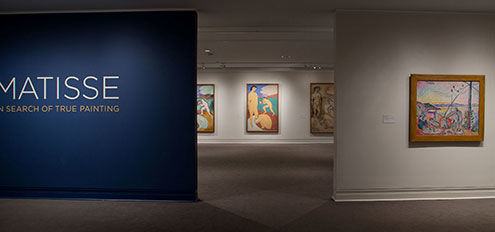
© 2012 Succession H. Matisse / Artists Rights Society (ARS), New York
Matisse's Early Pairs
Matisse turned thirty in 1899, the year he painted Still Life with Compote and Fruit (1899) and Still Life with Compote, Apples and Oranges (1899). He had not yet received any critical recognition and worried that he would be unable to support his growing family. For an artist on a limited budget, still lifes were an obvious and inexpensive subject. Rather than rework a single picture until it reached a definitive state, Matisse painted these two interpretations on identically sized canvases. It is not known which was begun first. Both are related to a larger composition of that year, Sideboard and Table (Kunsthaus Zürich).
An Interest in Contemporary Art
Matisse enjoyed looking at the contemporary art displayed in Parisian galleries. He was particularly intrigued by the work of Paul Cézanne (1839–1906) and Paul Signac (1863–1935). In 1904–5 Matisse painted the same still life in two different ways. The green and violet clusters of diagonally placed brushstrokes in Still Life with Purro I (1904) evoke passages in certain of Cézanne's paintings, while the vivid colors and confetti-like effects of Still Life with Purro II (1904–5) are derived from Signac.
Cézanne had exhibited twice with the Impressionists in the 1870s before settling into obscurity in the south of France. His first solo exhibition in Paris, in 1895, led to his rediscovery by collectors and artists, who were impressed by his efforts to unify form and color. Signac, meanwhile, was establishing a following for his canvases covered with methodically applied strokes of paint. His approach was rooted in scientific color theory and the conviction that juxtaposed touches of color produce luminous effects. In the Still Life with Purro paintings, Matisse borrowed stylistic elements from both artists but was more interested in rendering his own sensations than subscribing to either of their theories.
The Allure of Saint-Tropez
Matisse's first solo exhibition opened in Paris in June 1904. A few weeks later, he and his family headed to Saint-Tropez at the recommendation of the artist Paul Signac. In The Gulf of Saint-Tropez (1904), Matisse depicts his wife and his son overlooking a radiant Mediterranean sunset. Matisse's definitive presentation of the scene, Luxe, calme, et volupté (1904), is painted in the Divisionist mode championed by Signac. The painting's title refers to a refrain from Baudelaire's poem L'Invitation au voyage, which describes a world "in a warm glow of light." In this painting, Matisse again depicts his wife and his son (presumably the standing figure wrapped in a towel) but this time incongruously positions them among a group of nude bathers at a picnic. When the painting was first exhibited, at the 1905 Salon des Indépendants, critics faulted Matisse for appropriating the styles of other artists without asserting his own personality. Signac, however, considered Matisse a talented acolyte and acquired the picture for his dining room in Saint-Tropez.